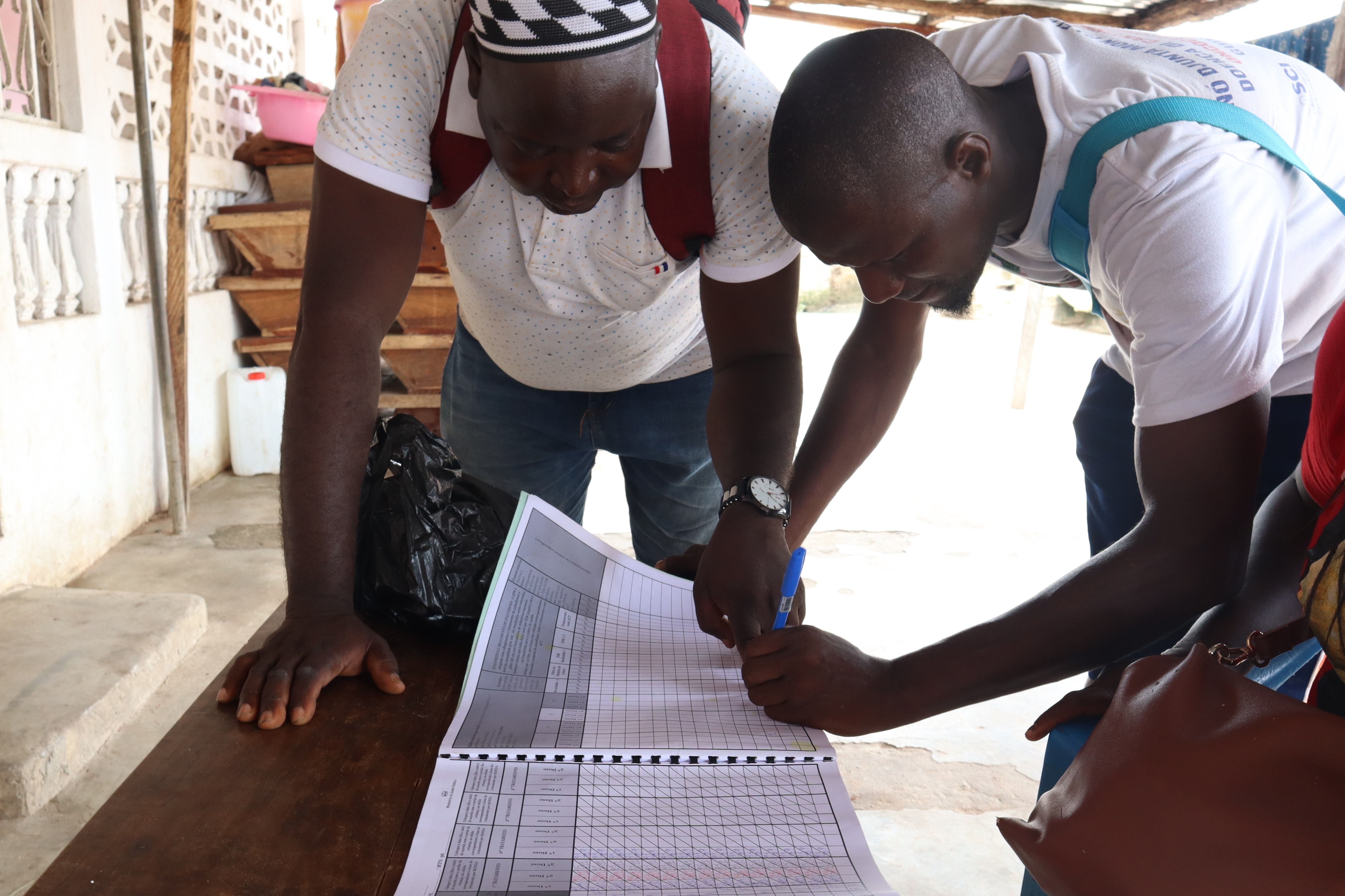Community Health Workers: the First Line in the Public Health Chain
December 14, 2022
Community health workers in the Safim health district
"Without community health, it is difficult to get people to come for consultations. We go to the communities to sensitise them”. Valdimar Luis Mancanha, a community health worker since 2014, is clear about this. He works hand in hand with his colleague Nosolino Sá in the Safim health district of the Biombo Regional Health Directorate and every day they visit several households to talk to them about important issues such as clean water consumption, diarrhoea, pneumonia, or new-born care. “When we started working, we faced some difficulties because the community didn't really understand what we were doing. They found it annoying that we were there, but that has changed over time” Valdimar says.
The Alma-Ata Declaration of 1978 identified primary health care as the key to achieving the goal of ensuring health care for all, and Guinea-Bissau was a global pioneer in community health. Indeed, community health blossomed in the country between 1977 and the civil war of 1997-1998. During the conflict, international aid replaced the traditional support provided by local people to community health workers, which came in the form of locally grown rice to be exchanged for health care. But after the war, when international support ceased and community support was no longer available, the role of community health workers was also extinguished. As of 2012, with UNICEF, EU, UNDP and The Global Fund support, that role was revived, and the 2nd generation of workers started being trained and working that year. “Guinea-Bissau's public health system operates at three levels: national, regional and community. At the national level, the Ministry of Public Health is responsible for managing the programmes and the reference hospitals, located in the country's capital” explains Dr. Agostinho Ndumba, Director General of Prevention and Health Promotion. “At the regional level, there is a Regional Health Directorate and a hospital in each of the 11 health regions. Administratively, the regions are divided into 114 health districts and each district have several health centres. At the community level, it is the community health workers who operate directly with the population to make the initial contact”. In Guinea-Bissau, there are large differences in access to health care between urban and rural areas. According to UNICEF data, it is estimated that 66% of the population lives more than 5 km from the nearest health facility and health services are mainly concentrated in Bissau and the regional capitals.
Health worker at the Mother and Child Centre in Gabu
Iankuba Indjai works in the village of Gan-Tauda tabanca, in the Bafatá health district. His work is mainly part of the implementation of the Seasonal Malaria Chemoprevention Campaign (SMC), recommended by the World Health Organisation for sub-Saharan Africa and promoted by UNDP and PNLP with the support of The Global Fund, but is not just limited to this. Like his colleagues Valdimar and Nosolino, Iankuba is also responsible for 18 major health issues such as education on existing health problems and methods to prevent and address them, mother and child health care, immunisation against major infectious diseases or the prevention and control of local endemic diseases, as well as the provision of essential medicine. "Each month we choose four practices that we raise awareness about" says Nosolino. "The essential thing is to make households conscious of what to do. We carry support materials and rapid screening tests for suspected malaria in children under five and pregnant women. We do awareness-raising on intermittent preventive treatment for pregnant women and on the free routine distribution of long-lasting impregnated mosquito nets (MILDA) during child immunization, regardless of the season”.
On their visit to the N'Tussinho community, Valdimar and Nosolino are joined by 30-year-old Sisaltina Camara and her four-month-old baby Juelce. In both of her pregnancies, Sisaltina was given intermittent preventive treatment for pregnant women at five of the seven pre-natal visits she attended. "Our work is essential because it helps to raise awareness in the community about the benefits of free pre-natal visits for pregnant women, so that they know how their babies are doing," Valdimar reflects. The clear objective set by the Ministry of Public Health in the country is to reduce maternal and infant mortality. According to the latest WHO's World Health Report, maternal mortality in Guinea-Bissau was 667/100,000 in 2021, more than double the 315/100,000 in neighbouring Senegal. In terms of neonatal mortality rate, sub-Saharan Africa has the highest neonatal mortality rate in the world, with 27 deaths per 1000 live births, and according to the same source, neonatal mortality stood at 35 deaths per 1000 live births in Guinea-Bissau. Babies under 6 months and pregnant women must be referred to health centres because community health workers do not have the tools to treat them in the field. “Normally we do first aid. We have basic medicine with which we can treat non-critical illnesses, and this reduces the overcrowding in health centres” Nosolino tells. “We see what people suffer from, and when it is necessary to take someone to hospital. At first people refused because they said it would be too expensive, but after we inform and sensitise and indicate which services are free, there are no longer these misgivings to accept referrals" concludes Iankuba.

Iankuba working during the SMC in Bafata
This relationship of trust that is established between community health workers and the people in the communities in which they intervene is key to the success of the first line in the public health chain in Guinea-Bissau. This relationship and the direct liaison between these essential workers and the health facilities are fundamental to making significant progress in building an accessible and inclusive public health system for all Bissau Guineans and to achieving SDG 3 - Ensure healthy lives and promote well-being for all at all ages.

 Locations
Locations